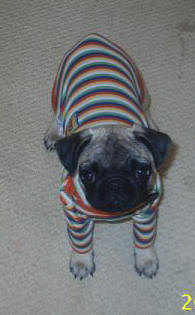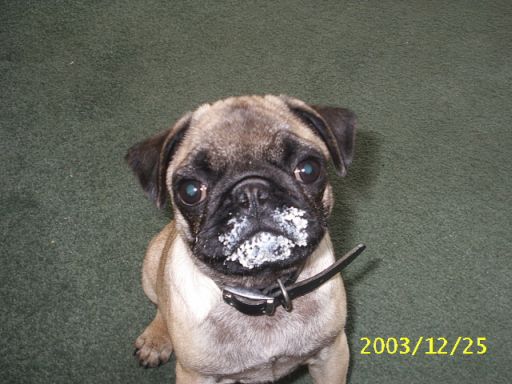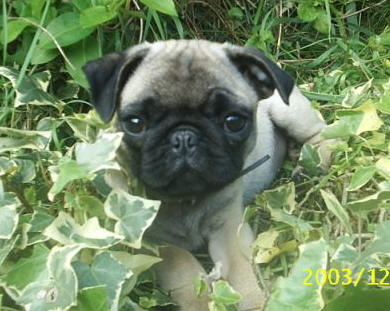Dogs for sale
Pet Supplies
How to draw a dog
Join Our Dog Forum FREE!
Trendy Dog Clothes
Dog Supplies
Dog Forum
Dog Health
Dog Articles
Dog Posters
2010 Dog Calendars
Dog Cages
Portable Dog Crates
Electronic Dog Doors
Dog Kennels
Small Dog Clothes
Slow Cooker Recipes
Dog Leads
Pet Travel Guide
Toy Dogs Guide
Dog Supplements
Dog Medicine info
Dog Allergies
Dog Portraits
Dog Resources
Sitemap

Pugs: Pug Dogs & Puppies
Pugs are people-oriented dogs, right down to the fact that they go through stages of maturity. Pug Puppies are especially playful and always underfoot for want of company.
If you have another dog, a pug puppy will often seek out their company for play and adventure. The puppy stage often lasts until the pug is about 2 years old, so be prepared with plenty of patience!
Older dogs seem to "settle" into a daily routine, and can be almost invisible until you want them. Pugs want nothing more than to please their owners, but you will have to show them just what it is you want! They are not mind readers!
More Pug dog information:
There seems to be no doubt that the fawn-coloured Pug enjoys the antiquity of descent that is attached to the Greyhound, the Maltese dog, and some few other venerable breeds.
Although much has been written on the origin of these dogs, nothing authentic has been discovered in connection with it. Statements have appeared from time to time to the effect that the Pug was brought into this country from Holland. In the early years of the last century it was commonly styled the Dutch Pug. But this theory does not trace the history far enough back, and it should be remembered that at that period the Dutch East India Company was in constant communication with the Far East. Others declare that Muscovy was the original home of the breed, a supposition for which there is no discernible foundation.

Pug History
The study of canine history receives frequent enlightenment from the study of the growth of commercial intercourse between nations, and the trend of events would lead one to the belief that the Pug had its origin in China, particularly in view of the fact that it is with that country that most of the blunt-nosed toy dogs, with tails curled over their backs, are associated.
The Pug was brought into prominence in Great Britain about sixty years ago by Lady Willoughby de Eresby, of Grimthorpe, near Lincoln, and Mr. Morrison, of Walham Green, who each independently established a kennel of these dogs, with such success that eventually the fawn Pugs were spoken of as either the Willoughby or the Morrison Pugs. At that period the black variety was not known. The Willoughby Pug was duller in colour than the Morrison, which was of a brighter, ruddier hue, but the two varieties have since been so much interbred that they are now undistinguishable, and the fact that they were ever familiarly recognised as either Willoughbys or Morrisons is almost entirely forgotten. A "fawn" Pug may now be either silver grey or apricot, and equally valuable.

Whatever may have been the history of the Pug as regards its nativity, it had not been long introduced into England before it became a popular favourite as a pet, and it shared with the King Charles Spaniel the affection of the great ladies of the land. The late Queen Victoria possessed one, of which she was very proud. The Pug has, however, now fallen from his high estate as a ladies' pet, and his place has been usurped by the Toy Pomeranian, the Pekinese, and Japanese, all of which are now more highly thought of in the drawing-room or boudoir. But the Pug has an advantage over all these dogs as, from the fact that he has a shorter coat, he is cleaner and does not require so much attention.
It was not until the establishment of the Pug Dog Club in 1883 that a fixed standard of points was drawn up for the guidance of judges when awarding the prizes to Pugs. Later on the London and Provincial Pug Club was formed, and standards of points were drawn up by that society. These, however, have never been adhered to. The weight of a dog or bitch, according to the standard, should be from 13 lb. to 17 lb., but there are very few dogs indeed that are winning prizes who can draw the scale at the maximum weight.

One of the most distinctive features of a fawn Pug is the trace, which is a line of black running along the top of the back from the occiput to the tail. It is the exception to find a fawn Pug with any trace at all now. The muzzle should be short, blunt, but not upfaced. Most of the winning Pugs of the present day are undershot at least half an inch, and consequently must be upfaced. Only one champion of the present day possesses a level mouth. The toe-nails should be black according to the standard, but this point is ignored altogether. In fact, the standard, as drawn up by the Club, should be completely revised, for it is no true guide.
The colour, which should be either silver or apricot fawn; the markings on the head, which should show a thumb-mark or diamond on the forehead, together with the orthodox size, are not now taken into consideration, and the prizes are given to over-sized dogs with big skulls that are patchy in colour, and the charming little Pugs which were once so highly prized are now the exception rather than the rule, while the large, lustrous eyes, so sympathetic in their expression, are seldom seen.
The black Pug is a recent production. He was brought into notice in 1886, when Lady Brassey exhibited some at the Maidstone Show. By whom he was manufactured is not a matter of much importance, as with the fawn Pug in existence there was not much difficulty in crossing it with the shortest-faced black dog of small size that could be found, and then back again to the fawn, and the thing was done. Fawn and black Pugs are continually being bred together, and, as a rule, if judgment is used in the selection of suitable crosses, the puppies are sound in colour, whether fawn or black.
In every respect except markings the black Pug should be built on the same lines as the fawn, and be a cobby little dog with short back and well-developed hind-quarters, wide in skull, with square and blunt muzzle and tightly-curled tail.